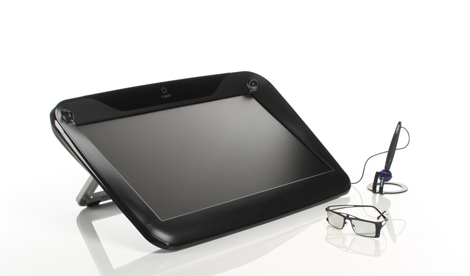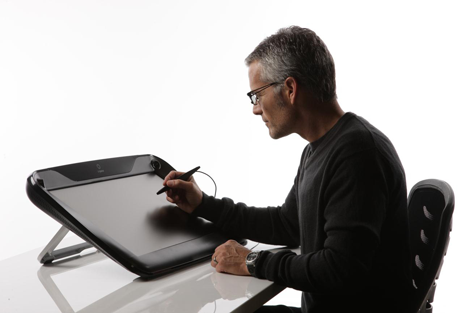
Slimmed down from the original prototype, the production ready zSpace device is brining holographic display and 3d interaction to low-cost, portable (ok, portable-ish) devices
Consider the term Virtual Reality. What do you think of? The Matrix, Star Trek’s Holodeck or go forbid, Lawnmower Man? Something like that. For the mainstream, Virtual Reality is something that’s more sci-fi than practically usable.
But for those working in the automotive and aerospace sector, the VR cave, the immersive environment is commonplace. Let’s face it, when you’re working on a product of that scale (think, car upwards), then a 24″ monitor really isn’t going to cut the mustard. As a result, a whole industry as been built to support the integration of all manner of devices, of technology, of large scale displays, of head or hand mounted motion tracking devices – to create full scale visualisation facility. Look at the fantastic work that the likes of Virtalis or Holovis do (there are some interesting stories on both Holovis and Virtalis from previous issues).
These types of facilities are a large capital cost and unless you’re working for the larger organisation, then you’re pretty much stuck with the 27″ LCD and maybe a pair of stereographic goggles if you’re lucky. What if there was something that was much more cost effective. Something that allowed you to interact with 3D data in a 3D manner. Something that didn’t require sectioning off a corner of the office and could be used by everyone?
This is the challenge that Infinite Z are looking to overcome.
Having first seen the device at COFES (Congress on the Future of Engineering Software) about four or five years ago, Infinite Z has moved beyond its prototype stage and started to bring its product to market. The fine folks at Core77.com have a rather nifty video showing the prototype from last year’s AU event.
Along the way the technology has been repackaged and the team has picked up a few key new members along the way. Perhaps the most notable is a gentleman by the name of Scott Harris. One of the founders of SolidWorks, Scott’s expertise in bringing 3D technology to market is well known. So it was with some excitement that I got word that the zSpace device was coming to market and was to be launched at Autodesk University.
How does it work?

Fans of Wacom’s Cintiq products will recognise the ergonomic styling and use model of the zSpace device
But what this does is something different.. It’s a 24″ holographic display. You have the stereographic screen, a set of specs and a pen. The display has tracking devices fitted which track the specs. And the specs make the geometry appear in 3D. I’m not usually a fan of these things, but this work and works nicely. You can look around an object as you would in real life. The pen comes into it to help with manipulation of objects, with setting viewing angles. Apparently there’s a version running with Autodesk’s Showcase on the show floor so I’ll be heading down there as soon as I can to see how it works with a real-world application.
There’s a good video on the website, but I can’t embed it here for some reason – but it IS worth a watch.
Potential use cases?
Having sat down and had a play with this thing, there’s huge potential for it. The visual richness is amazing and I could see customer presentations going down a storm just using it for that – particularly with high-investment or maybe luxury items. For those working with complex products, the ability to visualise them, to interact with them, is huge. It’s just a rich experience – but as ever, it’ll come down to how the capabilities are integrated into the professional applications.
Mainstream comes down to cost
So. It’s cool, right? It looks like technology from the future. And from seeing it in action, it works rather delightfully. So how much is it going to be you may ask. The answer surprised me. While it’s not finalised, the cost for this device is thought to be in the region of $6,000.
Yup. Six grand. In dollars. Now to my mind, that’s fascinating. The ability to have a high resolution 3D display with which you can interact with 3D data in an immersive environment, that you can throw in the back of the car (ok. place. gently) and take to customers, is fascinating. And I want one. Badly.






